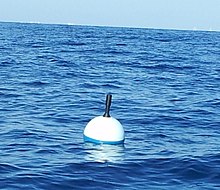Drifter (floating device)

A drifter (not to be confused with a float) is an oceanographic device floating on the surface to investigate ocean currents and other parameters like temperature or salinity.[1] Modern drifters are typically tracked by satellite,[2] often GPS. They are sometimes called Lagrangian drifters since the location of the measurements they make moves with the flow. A major user of drifters is the Global Drifter Program.

Construction principle[]
The major components of a drifter include surface floats for buoyancy, underwater drogues to ensure the drifter follows the movements of the water and is unaffected by wind, instruments (e.g., data collecting instruments, transmitters to transmit the collected data, and GPS devices), and waterproof containers for instruments.[3][4] Drifters are a technological evolution of ocean current analysis historically performed through drift bottle experiments, which in turn were built on the principle of a message in a bottle.[5]
Applications[]
Physical oceanography[]
Drifters provide real-time information about ocean circulation. They make more accurate and frequent observations of surface current velocity than is possible from remote sensing measurements.

Biological oceanography[]
Drifters are frequently used to collect information on biological oceanography, such as transport of organisms.
Lagrangian drifters may be chosen over more Eulerian-type seagliders for biological research when the advective effects, or influence of mixing water, is to be minimized. See Lagrangian and Eulerian specification of the flow field. Drifters are meant to follow a water parcel as it moves rather than measuring water properties in a specific area. They are generally sent to depth at a specific isopycnal, or line of constant density, before beginning measurements. This depth is usually below the influence of surface winds and mixing. Drifters are used to show the specific water parcel changed over time while gliders which move independently over the water can give larger spatial context.[7]
An example of drifters being used is the North Atlantic Bloom (NAB) experiment looking at physical and biological process in phytoplankton blooms. Dissolved compounds and nutrients, such as O2, NO3, and particulate organic carbon (POC), change within a bloom on various temporal and spatial scales. The drifter measured these compounds, and because drifters are “patch-following”, the influence of water mixing was minimized. Any changes to these oxygen and nutrient levels can be considered ‘internal’ to the water parcel and likely a result of processes such as photosynthesis or respiration that occurred within the parcel itself.[7]
Types[]
- CODE drifter[8]
- SVP drifter
See also[]
- Ice rafting, another means to investigate ocean circulation
- Swallow float
- Pearn P. Niiler – responsible for many developments in drifter technology and establishment of the Global Drifter Program
- Friendly Floatees
References[]
- ^ "What's a drifter?"
- ^ Global Drifter Program
- ^ "Drifters"
- ^ "Dissect a Drifter"
- ^ "NWFSC's Own Message in a Bottle: Ocean Drifters and Tiny Tags Have Been Telling Stories for Decades". NOAA's NWFSC. 2013. Archived from the original on July 24, 2016.
- ^ "Doing Their Part: Drifter Buoys Provide Ground Truth for Climate Data". NOAA (climate.gov). May 16, 2013. Archived from the original on December 19, 2015.
- ^ Jump up to: a b Alkire, MB, MJ Perry, E D’Asaro, and CM Lee. "Using sensor-based, geochemical measurements from autonomous platforms to estimate biological production and export of carbon during the 2008 North Atlantic Spring Bloom". Ocean Carbon and Biogeochemistry News. 6 (2). hdl:1912/6042.CS1 maint: multiple names: authors list (link)
- ^ "Nearshore Circulation in the Bering Sea"
- Oceanographic instrumentation
- Scientific equipment